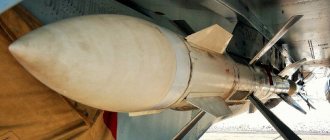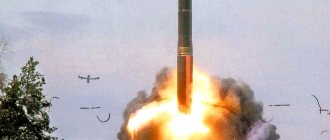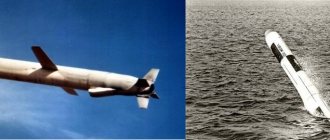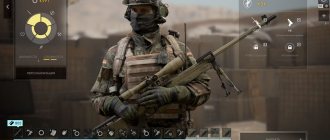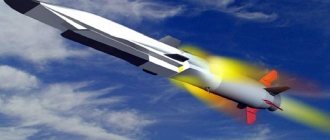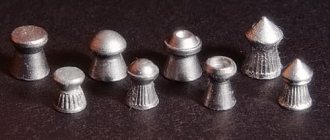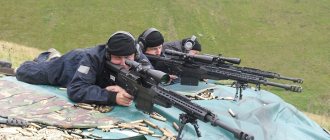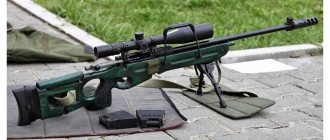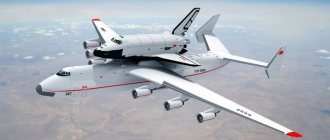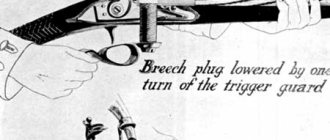Intercontinental missile V-2 from the German Vergeltungswaffe 2, or in English “Retribution Weapon 2” - “Weapon of Retribution 2”. The technical name of the project was Aggregat 4 (A4), which was the world's first guided intercontinental ballistic missile. The liquid-fuel rocket was developed in Germany during World War II as a "revenge weapon", and was intended to strike Allied cities in retaliation for the Allied bombing of German cities.
The first photograph of the Earth's surface from space was taken using a V-2 rocket launched by American scientists on October 24, 1946.
In addition, the V-2 rocket is the world's first man-made object to go into space, crossing the Karman line (rising to an altitude of over 100 km) by vertical launch from MW 18014 (Peenemünde Research Center) on June 20, 1944 .
Research work on the military use of intercontinental missiles began when Wernher von Braun completed his graduate studies (Figure 1), these studies attracted the attention of the German army. The prototype series culminated in the creation of the prototype known as the A-4 missile, which entered the war as the V-2.
Picture 1 . The author of the V-2 series rocket project was Wernher von Braun, in 1945.
Beginning in September 1944, there were over 3,000 V-2 missile launches by the German Wehrmacht against Allied cities, first against London and then against Antwerp and Liege. Which led to the death of approximately 9,000 civilians and military personnel.
Following Germany's surrender, Allied commands—the United States, the United Kingdom (Figure 2), and the Soviet Union—sought to seize key German manufacturing sites and technologies. The designer of the V-2 rocket, Wernher von Braun, and more than 100 other engineers surrendered to the Americans. Eventually, many of the original German team (Penemünde Research Center) designers of the V-2 rocket ended up at Redstone Arsenal.
US officials also seized enough V-2 equipment to assemble about 80 missiles on US soil. After the end of the war, the Soviets also acquired production capacity for the V-2 rocket and restored missile production in the Soviet Union. The Soviet analogues of the German missiles were called R1 and R-2.
Figure 2 . Test launch of a captured V-2 rocket in Great Britain; Soviet “specialists” were also invited to these launches; S. Korolev was present at one of the launches in the uniform and with shoulder straps of an “artillery captain.”
The history of the creation of the V-2 intercontinental missile
At the end of the 20s of the last century, a young engineer Wernher von Braun bought a copy of the book by Hermann Oberth “Die Rakete zu den Planetenräumen” (“The Racket in Interplanetary Space”) - pictures 3 and 4. From 1930 he studied at the Technical University in Berlin, where he assisted Oberth in testing liquid-fuel jet engines. Von Braun was working on his doctorate when the Nazi Party gained power in Germany. The artillery captain, Walter Dornberger, organized an ammunition department research grant for von Braun, which from then on operated next to Dornberger's existing solid rocket test site at Kummersdorf.
Figure 3 . First page of Hermann Oberth's book "Die Rakete zu den Planetenräumen".
von Braun's dissertation: "Design, theoretical and experimental solution to the problem of a liquid-propellant launch vehicle" (dated April 16, 1934), was assigned for use by the German army, and was not cleared for public publication until 1960. By the end of 1934, his group successfully launched two rockets that reached altitudes of 2.2 and 3.5 km.
At that time, Germany was very interested in the research of the American physicist Robert H. Goddard. Before 1939, German engineers and scientists sometimes turned directly to Goddard for technical questions. Von Braun used Goddard's plans from various magazines to create the Aggregat (A) series of rockets, named for the German word for mechanism or mechanical system.
After the successes at Kumersdorf with the first two rockets of the Aggregate series, Wernher von Braun and Walter Riedel began to think about a much larger rocket in the summer of 1936 based on the 25-ton thrust engine they were creating.
After the A-4 project was shelved due to an unfavorable aerodynamic stability test of the A-3 in July 1936, von Braun continued development of the A-4 rocket in 1937. And after "an extensive series of test firings of the A-5 series test model", using an engine redesigned from Walter Thiel's early A-3 series, technical documentation and design of the A-4 missiles were ordered in the 1938/39 period. During September 28 – 30, 1939, a “Wisdom Day” meeting was held in Peenemünde, dedicated to funding university research to solve rocket problems.
Figure 4 . The rocket project proposed by Hermann Oberth, and which was embodied in metal by Wernher von Braun.
By the end of 1941, the Army Research Center at Peenemünde had the technology necessary to successfully launch the A-4 missile.
The four key technologies of the A-4 missiles were:
- ⦁ large liquid fuel jet engines;
- ⦁ supersonic aerodynamics;
- ⦁ gyroscopic control system and mechanical computer;
- ⦁ control rudders in a gas jet.
In early September 1943, von Braun promised the Long Range Bombardment Commission that the development of the A-4 missile would be "practically completed or completed", but even by mid-1944 a complete parts list for the A-4 missile was still unavailable. Hitler was sufficiently impressed by the enthusiasm of his developers and needed a "miracle weapon" to maintain German morale that he authorized the deployment of missiles in large numbers. V-2 rockets were assembled at the underground Mittelwerk plant using prisoners from the Mittelbau-Dora concentration camp.
UR-100N (SS-19 Stiletto), Russia – 10,000 km
- UR-100N, according to the START treaty - RS-18A, according to NATO classification - SS-19 mod.1 Stiletto. This is a fourth-generation ICBM in service with the Russian Strategic Missile Forces.
- The UR-100N entered service in 1975 and is expected to be in service until 2030.
- Can carry up to six individually targetable warheads. It uses an inertial target guidance system.
- The missile is two-stage, silo-based. Rocket engines use liquid rocket fuel.
Technical details of the V-2 rocket
In the A-4 rocket, a mixture of 74% ethyl alcohol and liquid oxygen was used as an oxidizer for fuel. Reservoirs for alcohol and oxygen in the rocket were made of magnesium-aluminum alloy (Figure 5). The fuel tanks of the A-4 rocket contained 4173 kilograms of ethyl alcohol and 5553 kg of liquid oxygen.
Figure 5 . The fuel tank of a V-2 rocket with a rocket skin element; in addition, the fiberglass lining for thermal insulation of the fuel tank is clearly visible.
After launching the A-4 rocket, its engine operated independently for 65 seconds, and a software sensor controlled its pitch to a specified angle until the engine stopped (Figure 7), after which the rocket continued to move along the ballistic trajectory of free fall.
In 65 seconds, the rocket reached an altitude of 80 km, after which the engine was turned off. The fuel and oxidation pumps were driven by a steam turbine (Figure 6), and steam was produced by concentrated hydrogen peroxide with a sodium permanganate catalyst.
Figure 6 . Steam turbine of a V-2 rocket jet engine.
The temperature in the combustion chamber reached a range from 2500°C to 2700°C. Alcohol-containing fuel was pumped along the double wall of the main combustion chamber. This regenerative cooling heated the fuel and cooled the combustion chamber. The fuel was then pumped into the main combustion chamber through 1,224 nozzles, ensuring the correct mixture of alcohol and oxygen at all times.
The small holes also allowed some alcohol to escape directly into the combustion chamber, forming a cooled boundary layer that further protected the combustion chamber walls, especially at the combustion chamber throat, where the combustion chamber diameter was narrowest.
Figure 7 . Liquid-fuel jet engine of the V-2 intercontinental ballistic missile, with a thrust of 25 tons.
The boundary layer alcohol ignited upon contact with the atmosphere, producing a long, diffuse exhaust plume. In contrast, later V-2 engine designs that did not use this boundary layer cooling showed a translucent plume with no remaining unburned fuel.
Amatol 60/40 (a mixture of TNT - 60% and ammonium nitrate - 40%) was used as an explosive in the missile warhead. An electric contact fuze was used to detonate the main explosive. The advantage of amatol was its stability to high temperatures. The missile warhead was protected by a thick layer of fiberglass; this was done so that the amatol would not spontaneously explode when the missile warhead entered the dense layers of the atmosphere.
The missile warhead weighed 975 kilograms and contained 910 kilograms of explosives. Thus, the weight fraction of amatol in the warhead was 93%, a very high percentage compared to, for example, Soviet combat units. 65 kg accounted for the weight of the rocket control system: gyroscopes independent from each other and a mechanical (analog) computer - Figures 8, 8-1 and 8-2.
Figure 8 . Installation of gyroscopes in the warhead of the V-2 rocket.
Figure 8-1 . Independent gyros of the V-2 missile guidance system.
Figure 8-2 . View of the mechanical (analog) computer of the V-2 rocket control system.
A fiberglass protective layer (Figure 9) was also used for the fuel tanks, and as a result, the A-4 missile was not prone to internal surface icing, a common problem with other early missiles (such as the SM-65 Atlas missile's fuel tanks). .
Figure 9 . A thick layer of fiberglass was used not only to thermally insulate the missile warhead, but also the fuel tanks.
In flight, the V-2 rocket was controlled by four external rudders on the tail fins and four internal graphite rudders in the gas flow exiting the combustion chamber (Figure 10). The LEV-3's guidance system consisted of two free gyros (one for the horizontal plane and one for the vertical) to provide lateral stabilization, and a PIGA (computer analogue) accelerometer to control engine cut-off at a given speed.
The V-2 missile was launched from a predetermined location, so the distance and azimuth to the target were known. One missile stabilizer was aimed in azimuth at the target.
Figure 10 . Installation of internal graphite rudders before exiting the combustion chamber.
Some later V-2 missiles used "guidance signals", radio signals transmitted from the ground, to guide the missile on its target course. But the first series used a simple analog computer that adjusted the azimuth for the rocket, and the flight distance was controlled by the engine operating time. This device was called "Brennschluss".
It was later replaced by a Doppler system device, and there were also attempts to install various types of built-in accelerometers. This was done so that the rocket would stop accelerating and would soon reach the top of an approximately parabolic flight curve.
Dr. Friedrich Kirchstein of Siemens in Berlin developed a radio control for V-2 rockets to cut off the engine (Figure 11). To measure speed, Professor Wolman of Dresden created an alternative tracking system based on the Doppler effect in 1940-41. This involved using a ground signal transmitted to the A-4 to measure the missile's speed.
Figure 11 . A set of radio equipment from Siemens for V-2 missiles.
By February 9, 1942, engineer Peenemünde Beek defined the radio emission zone for the V-2 as 10,000 meters around the "shooting point" and the first successful flight of the A-4 on October 3, 1943, when radio control was used to cut off the engine.
Although Hitler commented on 22 September 1943 that "from our minds we have got rid of the radio control signal, there should now be no intervention for the British to technically interfere with a rocket in flight" about 20% of V-2 operational launches were radio signal oriented .
The Operation Pinguin V-2 missile offensive began on September 8, 1944, when personnel from Battery No. 444 received training from the Wernher von Braun team. For training and equipment testing, Battery No. 444 launched a single radio-controlled missile towards Paris. Speed and fuel cut transponders were sometimes found in the wreckage of V-2 combat missiles.
Figure 12 . V-2 combat missiles were painted olive green.
The V-2 operational missile paint job was primarily a variety of camouflage patterns with a few variations, but late in the war a simple olive green paint scheme appeared in the rocket color (Figure 12). During testing, the rocket was painted in a distinctive black and white checkerboard pattern, which helped determine whether the rocket was rotating around its longitudinal axis (Figure 13).
Figure 13 . The first launches of V-2 rockets in the United States took place in a “checkerboard coloring” of the rocket.
Notes
- Military encyclopedic dictionary. / Ed. S. F. Akhromeeva, IVIMO USSR. — 2nd ed. - M.: Voenizdat, 1986. - P. 598 - 863 p.
- Artillery // Encyclopedia "Around the World".
- ↑ 1 2 Lehmann, Jörn
. Einhundert Jahre Heidekrautbahn: eine Liebenwalder Sicht. - Berlin: ERS-Verlag, 2001. - S. 57 - 95 s. — (Liebenwalder Heimathefte; 4) — ISBN 3-928577-40-9. - Zborowski, H. von
;
Brunoy, S
.;
Brunoy, O.
BMW-Developments. // History of German Guided Missiles Development. - P. 297-324. - ↑ 1 2 3 4 Backofen, Joseph E.
Shaped Charges Versus Armor—Part II.
// Armor
: The Magazine of Mobile Warfare. - Fort Knox, KY: US Army Armor Center, September-October 1980. - Vol. 89 - No. 5 - P. 20. - Gatland, Kenneth William
. Development of the Guided Missile. - L.: Iliffe & Sons, 1954. - P. 24, 270-271 - 292 p. - ↑ 1 2 Schilling, M.
The Development of the V-2 Rocket Engine. // History of German Guided Missiles Development. - P. 296. - Benecke, Theodor
. Summary of German Developments in Guided Missiles. // History of German Guided Missiles Development. - P. 2. - Kolesov N.D.
Economic factor of victory in the Great Patriotic War. // The Great Patriotic War: truth and fiction: collection of articles. - St. Petersburg: St. Petersburg University Publishing House, 2006. - Issue. 3 - P. 17. - Shatagin N. I.
,
Prusanov I. P.
The Soviet Army is an army of a new type. - M.: Voenizdat, 1957. - P. 224-280 p. - Fitzsimons, Bernard
. The Illustrated Encyclopedia of 20th Century Weapons and Warfare. - NY: Columbia House, 1978. - Vol. 10 - P. 2603—2685 p. - Perelman Ya. I.
Tsiolkovsky, his life, inventions and scientific works. - M.: Gostekhnoteorizdat, 1932. - P. 54 - 64 p. - G. B.
Foreign new artillery weapons.
// Military Bulletin
: Combined arms and infantry magazine of the Red Army. - M.: Red Star, January 1936. - No. 1 - P. 65-67. - K. A.
Military incendiaries (according to foreign press data).
// Bulletin of air defense
. - M.: KOGIZ, May 1936. - No. 5 - P. 55-56. - Rocket / Sternfeld A. // Ravi - Robbia. - M.: Soviet Encyclopedia, 1941. - P. 202. - (Great Soviet Encyclopedia: [in 66 volumes] / chief editor O. Yu. Shmidt; 1926-1947, vol. 48).
- Chuikov V.I.
Guardsmen of Stalingrad are moving to the west. - M.: “Soviet Russia”, 1972. - P. 87-88 - 256 p. - Chuikov V.I.
In the battles for Ukraine (Guardsmen of Stalingrad in the battles against the fascist invaders for the liberation of Soviet Ukraine). - K.: Politizdat of Ukraine, 1972. - P. 73 - 192 p. - Chuikov V.I.
From Stalingrad to Berlin. - M.: Voenizdat, 1980. - P. 359 - 672 p. - (War memoirs). - Jung, Philippe
.
The True Beginnings of French Astronautics 1938—1959 (Part 1). // History of Rocketry and Astronautics
: Proceedings of the Thirty-Third History Symposium of the International Academy of Astronautics: Amsterdam, the Netherlands, 1999. - San Diego, Calif.: Univelt, 2007. - P. 83, 88 - 544 p . - (AAS History Series; 28) - ISSN 0730-3564 - ISBN 978-0-87703-539-8. - New Anti-tank Missile Ideas. // Aircraft
: Official Organ of the Royal Aeronautical Society. - November 1965. - Vol. 45 - No. 2 - P. 24. - Vannakh M.
Arab street in the digital era.
// Computerra
. — 02/10/2011 - Lipinski, Henry S.
Supporting Research Feasibility Studies for Recoilless Rifle Ammo. // Army Research Task Summary. - Washington, DC: US Army Research Office, Office of the Chief of Research and Development, 1961. - P. 307. - Javelin vs. Kornet: which ATGM is worse for tanks // Free Press, Nov 2016
- Khramchikhin Alexander.
Chapter 5. Military construction in China // Has the dragon woken up? : Internal problems of China as a source of the Chinese threat to Russia: [rus.]. — 2nd ed. - Moscow: Klyuch-S, 2020. - P. 63-64. — 192 p. — 500 copies. — ISBN 978-5-906751-22-5.
V-2 missile testing
The first successful test flight took place on October 3, 1942, the rocket reached an altitude of 84.5 kilometers. The highest rocket flight altitude was achieved during the war, it was 174.6 kilometers - June 20, 1944.
During the development and testing of the V-2, various design issues were identified and resolved:
- ⦁ To reduce the pressure and weight of the fuel tanks, high-pressure turbopumps were used to increase the pressure.
- ⦁ Small and lightweight burn-free combustion chamber has been designed using centrifugal injection nozzles, mixing chamber and converging throat nozzle for uniform combustion of fuel.
- ⦁ To prevent burnout in the neck of the combustion chamber, cooling films were used.
- ⦁ Relay contacts were made more durable to withstand vibration and prevent power loss immediately after takeoff.
- ⦁ Ensuring that fuel pipes have stress-free curves will reduce the likelihood of explosions by 1200 - 1800 m.
- ⦁ The pins were formed with clearance to prevent damage as the exhaust pipe expanded with height.
- ⦁ To control the movement along the trajectory after the launch and when supersonic speed is reached, heat-resistant graphite blades were used as rudders in the exhaust stream.
- ⦁ To prevent spontaneous explosions of the rocket upon entering the dense layers of the atmosphere, all tubes and pipes of the rocket were coated with tin.
Experimental launches of V-2 rockets in the UK, in the foreground a tanker based on the German Opel Blitz.
Korolev and his team
Chief designers
The Soviet missile program was handled by a group of engineers from NII-88, headed by S.P. Korolev. His closest assistants are V.P. Glushko, V.I. Kuznetsov, V.P. Barmin and N.A. Pilyugin were responsible for creating the main systems of future missile systems. Later they became general designers of leading design bureaus, which still form the core of the domestic rocket and space industry.
Launch of the first ballistic missile
The first domestic combat ballistic missile R-1 is a modified version of the German captured V-2, fragments of which were taken from Germany at the end of the war. The first launches took place in October 1948. The Soviet Union became a missile power.
